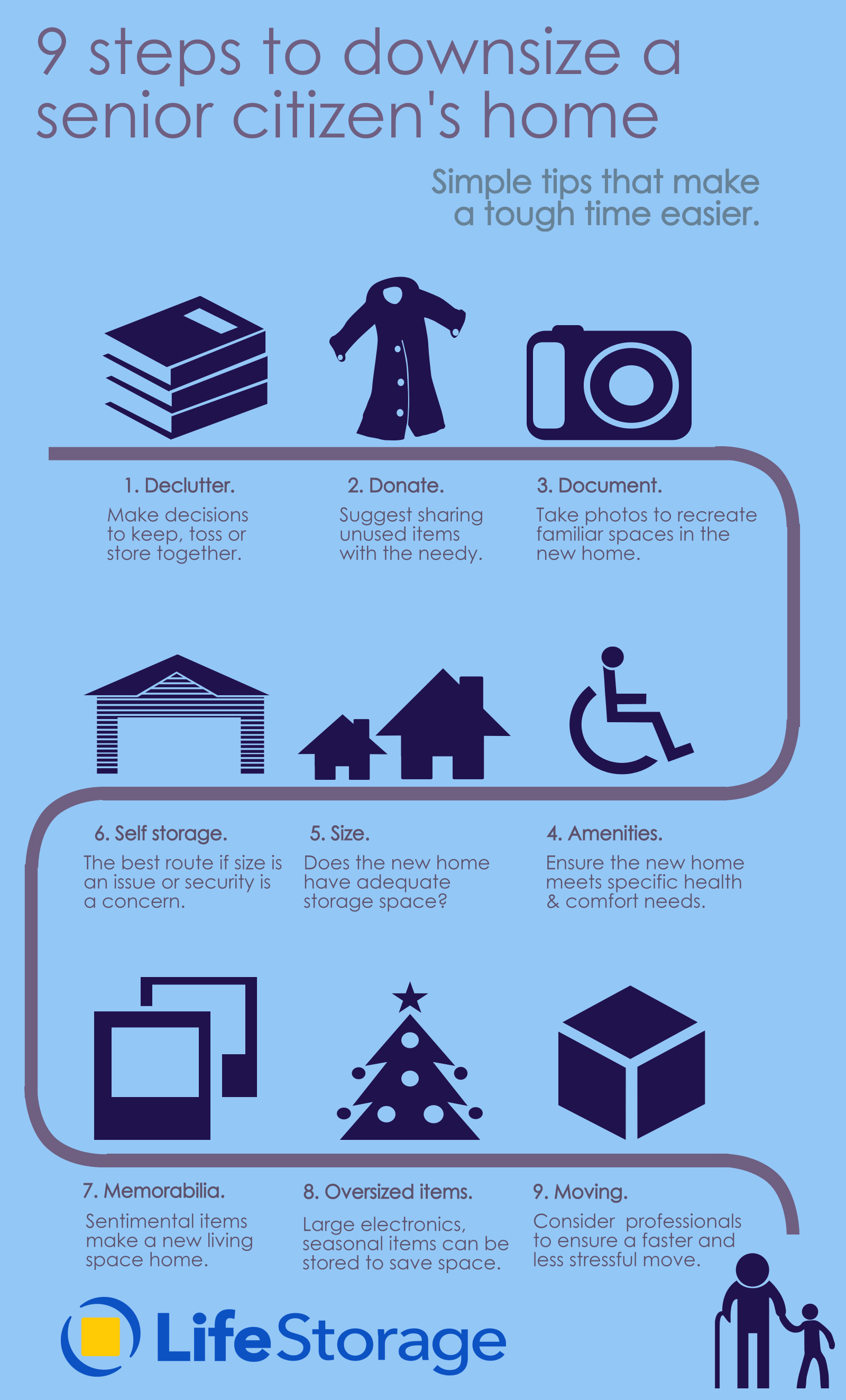When the time comes, downsizing for seniors can present many emotional and physical challenges. Sorting a household of possessions – and wading through a lifetime of memories – can be daunting for both seniors and their caregivers alike.
One thing to know before diving into the senior downsizing process: While difficult, it’s an incredibly common experience. According to Merrill Lynch, approximately 51% of retirees 50 and older decide to move into smaller homes after retirement.
With that decision comes the inevitable need to declutter and downsize a life’s worth of belongings, which is no easy feat. And if the need to downsize comes up unexpectedly due to health matters, a death in the family, or other concerns, the task’s weight can be even more challenging to process.
Find the Best Senior Downsizing Tips
As overwhelming and complicated as it may seem, downsizing can still be a net positive in a senior’s life. Not only does it alleviate stress and unnecessary clutter, but senior downsizing can also help cut living costs and create a simple and safe environment for your loved one.

If you’re in the process of helping a loved one downsize or move into a smaller home, you’re not alone. Read on for our essential checklist, packed with downsizing tips for seniors that will benefit everyone involved— while minimizing stress and maximizing productivity.
Related: Dealing With Moving Stress: Tips to Cope & Manage Anxiety
1. Evaluate and process the timing and reason for senior downsizing.
The first step in the senior downsizing process is to have an honest conversation with your loved one. Discuss why this is a necessary next step, assess the pros and cons of downsizing, consider the reasons directing the action, and talk candidly about whether or not now is the right time to start the process.
When should seniors downsize?
Ultimately, there’s no perfect time to begin the senior downsizing process. Retirement is typically one of the most common times people start the downsizing process, but health concerns or other life events may also serve as a catalyst.
In any case, keeping the lines of communication open and having a clear goal is crucial when beginning the senior downsizing process. That way, you will better handle overwhelming emotions by not springing the change on your loved one at the last minute. Give the entire family time to process what is about to happen and let them have space to adjust to the change.
Why is downsizing a good idea in retirement?
The reason for downsizing a senior’s home may vary among families. Some of the most common reasons for senior downsizing include:
- Maintenance. As individuals age, keeping up with everyday chores and household tasks can be difficult. Even if a senior has a spouse, partner, or family nearby, they may still want help with gardening, minor home repairs, meal deliveries, and housekeeping.
- Cost of living. Cutting housing costs is a quick way to save money and increase retirement savings. The smaller the space, the less you’ll have to spend on expenses like heating and electricity.
- Health Issues. For those with reduced mobility, physical abilities, vision, hearing impairments, and other medical needs, senior living communities can offer the services and amenities that the elderly population needs.
Related: Moving Tips for Seniors and People With Disabilities
2. Create a system for letting go of belongings.
As you begin the downsizing process, you might wonder: Can I really ask Mom and Dad to give up belongings they cherish so profoundly? How can seniors downsize in a way that allows them to maintain a sense of control and agency in their lives?
By creating a system, you can simplify your senior’s space, organize their possessions, and reduce the emotional attachment involved. When in doubt, go slowly and try to avoid tacking too much in a day. Not only is it a physically tiring process, but it can be emotionally exhausting, too.
Here are some systems you can start to implement once you know you will be downsizing a senior’s home:
- Declutter. More often than not, your first step will be to declutter the space. Get rid of anything unused or unwanted that doesn’t have an emotional attachment. This process will help you get in the mindset of letting go, which helps when you start making difficult decisions about items with more sentiment attached.
- Donate. Suggest donating specific items to family members or a non-profit instead of discarding them. Donating is a great way to let the senior know their item is valued; now, someone else can also love it. Local Goodwill locations and grandchildren may be more than willing to put their belongings to good use.
- Document. The fear of change can be paralyzing. Taking notes and pictures of items will allow you to recreate a similar setup in the new space and help you keep track of important documents and treasured items. Be as detailed as possible, from furniture arrangements to the placement of family photos on the walls.

Related: Inheriting a House Full of Stuff: Here’s What to Do
2. Consider the senior’s new space before downsizing.
Whether the new location is a condo, a small apartment, assisted living, or with another family member, planning as much as possible in advance is a good idea. From available amenities to where exactly items will go based on your open space, these details can help ensure a smooth transition.
Make sure you consider the following details of your senior’s new home:
- Amenities. What specific requests does your loved one have? Will they have physical needs or security measures? Plan the new space around these accommodations.
- Size. If the senior goes from a four-bedroom home to a studio apartment, a lot of downsizing will be required. Hone in on the most critical aspects of their lifestyle and figure out how to make room for the things that directly influence their daily routine. The less their lifestyle and habits change, the happier and more comfortable they will be in the long run.
- Storage. Is there realistic space for everything the senior wishes to keep? Personal documents, oversized items, or other belongings that may not be suitable for the smaller space may be more suited for a storage unit. Storage units have features like temperature-regulated units to keep belongings safe from harsh winters or hot summers. You can also consider renting a parking space or unit for an extra vehicle. Storage units come in a variety of sizes so be sure to do your research and pick the size best suited for your needs.
3. Consider getting senior downsizing help and using moving professionals.
One of the common reasons that keep seniors from moving is the fear that they won’t have a home for all their belongings. This is a pervasive and totally understandable fear. Luckily, there are tons of senior downsizing professionals out there who can help in several ways.
During the downsizing process— even after decluttering and donating— you may need a place to store larger items, personal belongings, and sensitive documents. Storage facilities and moving professionals can help provide safe and secure storage units (or other solutions!) catered to your unique situation.

Related: Hiring a Moving Company? Here’s Everything You Need to Know
What should you stow in a storage unit when helping a senior downsize? Here are a few everyday items to consider:
Memorabilia: A smaller space may only allow seniors to keep some things. But, of course, they should still be allowed to hold onto sentimental items. A small storage unit can provide a safe place to store these for now without forcing seniors to part with them. (Remember, some items may require climate-controlled storage.)
Oversized Items: Save space in the senior’s new home by storing large electronics, exercise equipment, and unused vehicles. Storage unit rentals are available on a monthly basis, so in some cases, temporary storage is also an option.
Pro tip: Some storage facilities offer packing and transition services, too! Working with senior downsizing professionals can make the process easier for everyone involved. Sometimes emotional drainage can even be avoided by hiring outside help to handle the heavy lifting. Storage unit facilities also offer moving trucks to assist in transporting and relocating belongings.
Many facilities may offer discounted prices for senior citizens, too! Be sure to shop around and inquire with multiple storage facilities and moving companies in your area.
Downsizing for Seniors Doesn’t Have to Be Difficult
Downsizing can be a particularly complicated and emotional process for senior citizens— but it doesn’t have to be. With appropriate planning, preparation, and organization, you and your loved one will have a hassle-free transition (and a much lighter load) in no time.

Do you have any best practices for downsizing a senior citizens’ home? Tweet us your thoughts @LifeStorage.
Updated on 2/22/23 & 5/7/19 from an article originally published on 12/5/18.







